Capítulo 9: A largada oficial da longa, árdua e quase interminável caminhada para chegarmos a Iguaçu 2008
Finalmente, após todas as atribulações anteriormente descritas quanto à sede a ser escolhida para abrigar o evento, como já foi amplamente descrito anteriormente, pudemos definitivamente colocar em marcha os trabalhos de organização do World Congress of Pediatric Gastroenterology, Hepatology and Nutrition III, Iguaçu 2008.
Nas figuras abaixo estão descritos os fluxogramas organizacionais especificando todas as entidades envolvidas no evento Congresso Mundial e suas respectivas funções.
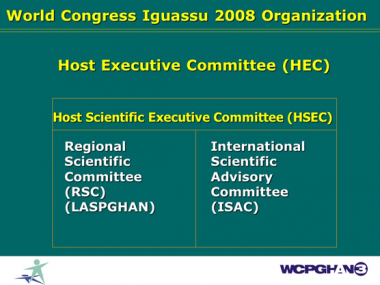
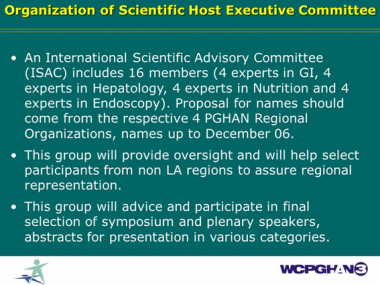
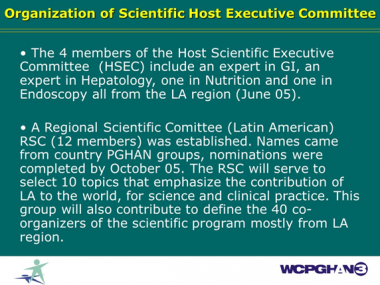
Para tal consecução, inicialmente como primeiro passo, foi constituído o Host Executive Committee, o qual tornou-se composto pelos seguintes membros:
Ulysses Fagundes Neto (Chairman)
J. Isidoro Kohn (Vice Chairman)
Domingos Jaen (Vice Chairman)
Carlos Alberto Garcia Oliva – Treasurer
Ulysses Fagundes – General Secretary
No dia 8 de abril de 2004 foi realizada a primeira oficial das atividades do Host Executive Committee. Como se lê abaixo, a primeira tarefa foi escolher a empresa que iria se responsabilizar pela organização operacional e quanto às questões de logística do evento, bem como a agência de turismo responsável pelo transporte e acomodação dos participantes. Foi realizada uma concorrência pública e os vencedores foram: Julio Cesar Urban – Idealiza Eventos, e Patrícia Sampaio – Blumar Turismo, respectivamente.
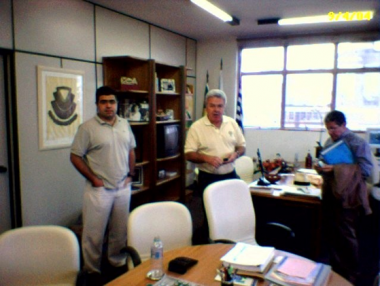
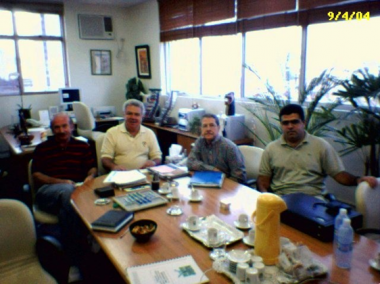
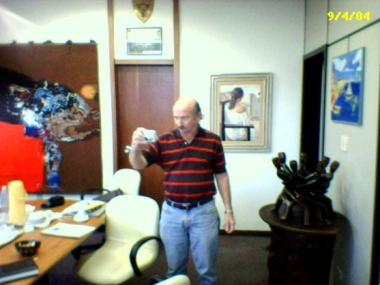
General Matters on the Agenda:
1- Overall briefing and discussion on the proposals presented by MCI France and Idealiza Eventos/Blumar for the operational organization of the Congress.
a) Briefing on Iguazu city and on FISPGHAN members´ trip in January.
b) Date confirmation and hotel reservations in Rio de Janeiro and Iguazu. Idealiza Eventos y Blumar Turismo hand in and present their proposal for organizing the event.
c) MCI France hand in their proposal to the Executive Committee members.
2- Issues addressed by the Host Executive Committee
a) The proposal presented by Idealiza eventos and Blumar Turismo was unanimously approved
b) Overall estimates and financial targets:
i. Total cost of the event: US$ 1,350,000
ii. Exceeding expenses related to payments due to FISPGHAN and affiliated societies: US$ 150,000
iii. Total financial resources needed: US$ 1,500,000
iv. Foreseen income:
1. Enrollments: U$ 400,000 to U$ 600,000
2. Stands: U$ 450,000 to 550,000
3. Satellites: U$ 480,000 to 500,000
4. Posters: U$ 30,000
c) The need to reach enrollment and/or general costs values that may allow the access of the greatest possible number of Latin American members and particularly younger professionals.
d) Composition of the Congress Organization Committees
e) Preliminary proposal for enrollment fees: (US$)
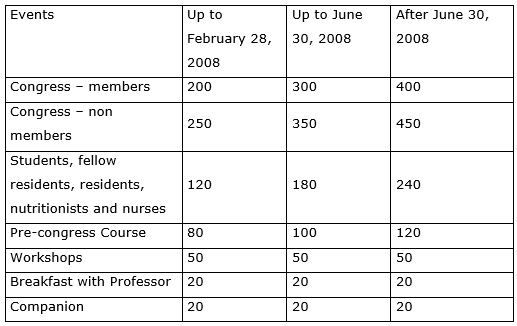
Imediatamente a seguir, a próxima etapa, foi elaborar a constituição dos demais Comitês, a saber:
Local Committee:
Aderbal Sabra
Elizabete Kawakami
Fábio Ancona Lopes
Francisco José Penna
Gilda Porta
Hugo Ribeiro
Isabel Scaletsky
José Taddei
Luciana Silva
Mauro Batista de Morais
Mauro Fisberg
Ramiro Antero de Azevedo
Themis Reverbel Silveira
Vera Lucia Sdepanian
Yu Lin Koda
Host Scientific Executive Committee:
Ricardo Uauy (President)
Daniel Dagostino
Eduardo Salazar Lindo
José Vicente Spolidoro
Jayme Belkind Gerson
Abstracts:
Paloma Jara
Claudio Morera
Carlos Velásquez
Working groups:
Carlos Lifschitz
Alejandro Costagurta
Danilo Mejias
International Committee:
Ricardo Coletti
Hans Buller
Geff Cleghorn
E-mail encaminhado em: 26/09/2005
Eduardo Cueto wrote:
Querido Ulysses
El gusto fue mío, además me gusto verte bien.
Has vuelto a tener brillo en los ojos.
Hare lo necesario (y mas) por nuestro congreso
En cuanto lleguen las madres hablare de Iguazu con ellas.
Mañana pido una entrevista con Roemmers.
Un abrazo
Eduardo
“Dijimos” la vez pasada: Boston fue difícil, Paris más aun,
pero a Iguazu llegamos a pie si es necesario.
E-mail encaminhado em: 26/09/2005
Ulysses Fagundes-Neto wrote:
Querido amigo Cueto:
Fue una gran alegría estar contigo en Salta, quiero agradecerte por tu magnifica hospitalidad y atención para la divulgación del NUESTRO Congreso Mundial. Aguardo el proyecto sobre Celiacos y también por favor alguna respuesta sobre la participación del Laboratorio Roemers.
Un fuerte abrazo,
Ulysses
CONVOCATORIA PARA REUNIÓN
28 Y 29 DE OCTUBRE 2005 – SÃO PAULO – BRASIL
III WCPGHAN – IGUAZU 2008.
Estimados amigos,
Según habíamos quedado en la última reunión (Cartagena) de los Comités Ejecutivo y Científico de Iguazu 2008, en octubre tendremos nuevo encuentro en São Paulo. Proponemos la siguiente programación:
Fechas: 28 y 29 de octubre 2005
Programación:
Día 28/10/2005:
10:00 – 11:00 horas – Apertura e Informes generales: Prof. Dr. Ulysses Fagundes Neto
11:00 – 14:00 horas- Comité Científico: Informe de los trabajos, nominaciones de las sociedades, programación futura y discusión.
Prof. Dr. Ricardo Uauy
Prof. Dr. José Vicente Noronha Spolidoro
Prof. Dr. Eduardo Salazar Lindo
Prof. Dr. Daniel D’Agostino
14:00 – 16:00 horas- Almuerzo
16:00 – 18:00 horas – Working groups
Prof. Dr. Jaime Belkind Gerson
18:00 –20:00 horas – Curso pre-congreso (SLAGNHP)
Prof.Dr. Carlos Alberto Velasco Benítez
Día 29/10/2005:
8:30 – 13:00 horas – Reunión del Comité Ejecutivo
Miembros invitados:
Comité Ejecutivo:
Prof. Dr. Ulysses Fagundes Neto
Prof. Dr. Domingos Jaen
Prof. Dr. Joaquin Kohn
Prof.Dr. Carlos Alberto Velasco Benítez
Prof. Dr. Carlos Alberto Garcia Oliva
Dr. Ulysses Fagundes
Dr. Julio Urban (Idealiza)
Comité Científico:
Prof. Dr. Ricardo Uauy
Prof. Dr. José Vicente Noronha Spolidoro
Prof. Dr. Eduardo Salazar Lindo
Prof. Dr. Daniel D’Agostino
Working Groups:
Prof. Dr. Jaime Belkind Gerson
El hotel, traslados y alimentación serán ofrecidos por la Organización del Congreso, con los recursos de la SLAGHNP en Brasil. Os pido urgencia en confirmar el recibimiento de esta convocatoria, la participación en la reunión y las fechas y horas de llegada a São Paulo. Creo de debemos todos pasar a utilizar el correo de la lista del congreso ([email protected]), facilitando la comunicación entre nosotros.
Un abrazo y hasta pronto,
Ulysses Fagundes Neto, Presidente
E-mail encaminhado em: 25/10/2005
Ulysses Fagundes Neto wrote:
Dear Geoff:
I have just arrived from the NASPGHAN meeting in Salt Lake City and I had the opportunity to talk to several colleagues regarding the organization of Iguassu 2008. In general they showed a great enthusiasm about the event although there were also some concerns. The most important concerns were about the distance (very far way needing a conexion flight), the prices of airfare and lodging, safety and mainly the lack of knowledge of the place. In an attempt to solve these problems Phil invited me to to give a brief talk in the Plennary Session next year in Orlando during NAPGHAN’s meeting. I think this was an excellent idea so I can answer all the questions related to the concerns that were pointed out by those colleagues.
On the other hand, some FISPGHAN members from NASPGHAN will not be able to go to Iguassu in March next year, so they asked me to get in touch with you in order to postpone the date of our meeting to April. I personally have no problems in postponing the date of the meeting. In this sense I think it should be more rationale to make a proposition of 3 different weekends to allow the election of one of those in which the majority of the FISPGHAN members could be present. I think it is urgent to call the meeting as soon as posible so our colleagues will be able to book their calendars in an appropriate time.
Best regards,
Ulysses
E-mail encaminhado em: 25/10/2005
Geoff Cleghorn wrote:
Ulysses, I am in Seoul Korea as we speak. I also have no problems with April and would be happy for you to do as you suggest and send out to everyone some alternative dates and we shall canvass the best one from the council members as you suggest. As I am away would you like to do this on my behalf please.
Your friend
Geoff Cleghorn
Elaboração do Logotipo do Congresso
Com relação à organização do evento propriamente dito uma das nossas prioridades foi contratar um profissional da área de publicidade para que elaborasse um logotipo que refletisse o espírito e a filosofia que queríamos dar ao Congresso Mundial. Deveriam estar claramente abordados os seguintes lemas: Ciência, Família, Lazer e Ecologia. O logotipo teria que ser elaborado de tal forma para que fosse possível desde o princípio identificar a ideia do nosso evento. Foi atendendo a estas características que os logotipos foram elaborados em português, espanhol e inglês como se pode abaixo identificar.
E-mail encaminhado em: 3/11/2005
Fabio Belik wrote:
Caros,
Segue am anexo o Power Point para o WCPGHAN. Retirei o “3rd” da logomarca e configurei a apresentação para se repetir indefinidamente até teclar “ESC”. Qualquer dúvida estou à postos.
Abraços,
Fabio Belik
E-mail encaminhado em: 3/11/2005
Ulysses Fagundes Neto wrote:
Caro Fábio:
Ficou melhor, porém é necessário colocar o número 3, algo como WCPGHAN-3.
Um abraço,
Ulysses
Esta solicitação foi prontamente atendida pelo Fábio, e, desta forma passamos a ter o logotipo definitivo do Congresso como mostram as figuras abaixo:
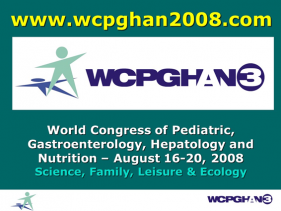
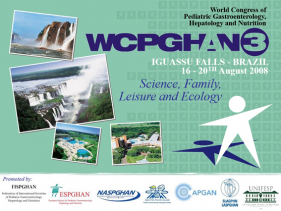
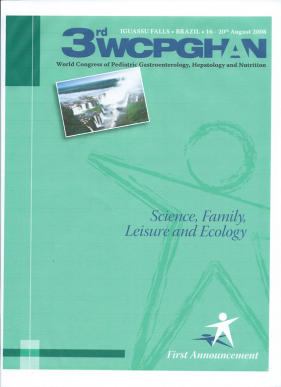
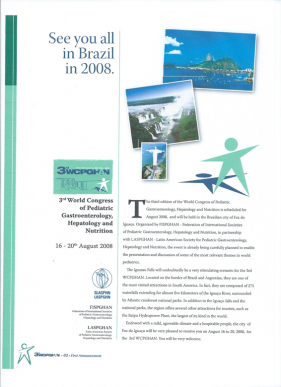
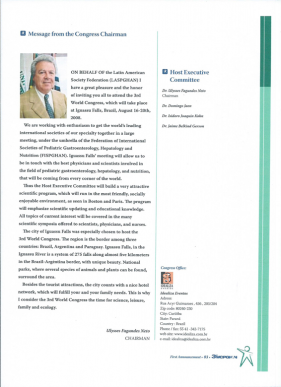
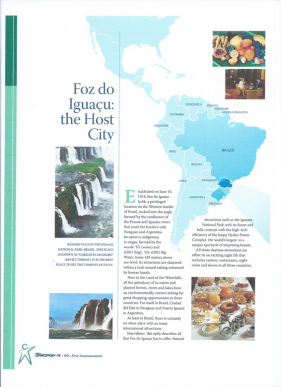
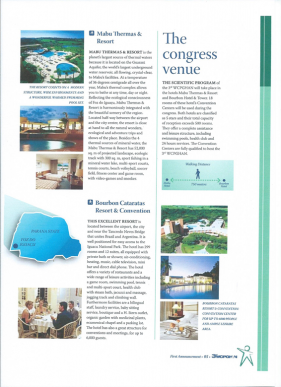
E-mail encaminhado em: 18/11/2005
Ulysses Fagundes-Neto wrote:
Caros Colegas:
Finalmente, ESPGHAN ha decidido participar en nuestros grupos de trabajo el Comité Científico y los Working Groups. Les adjunto copias de los mensajes recibidos. Ricardo pido te que me envíes a la brevedad el acta de los trabajos del Comité Científico para poder publicarla en la news letter de nuestro website.
Un fuerte abrazo,
Ulysses
Dear Ulysses,
I have positive answers from Riccardo Troncone and Dominique Turck as representatives of ESPGHAN for the world meeting in Iguazu.
As for the working groups I would like to know whether you need one person or more.At present Steffen Husby from Danemark is
responsible for the working groups (<[email protected]>).
Best Regards
Michael
Dear Ulysses,
I have a third representative out of the group of pediatric hepatologists:
Anil Dhawan from London. He agreed to take part in the organization.
Best regards
Michael
Stefano Guandalini
NOVA VISITA DA FISPGHAN A FOZ DO IGUAÇU
As outras pautas diziam respeito a uma nova visita dos membros da FISPGHAN a Foz do Iguaçu. Para aproveitar a vinda destes colegas elaboramos a programação de um Simpósio Internacional da especialidade com a finalidade de promover o futuro evento e também oferecer à nossa classe pediátrica uma oportunidade de atualização da mais elevada qualidade científica. Segue abaixo todo o programa planejado e que de fato foi executado quando da visita dos colegas da FISPGHAN.
FISPGHAN MEETING – SÃO PAULO – IGUASSU – APRIL 20-24, 2006
1- APRIL 20
ARRIVAL IN SÃO PAULO AND TRANSFER TO HOTEL
DAY FREE FOR SIGHTSEEING OR OTHER PERSONAL ACTIVITIES
14:00 –17:00 – VISIT TO THE MUSEUM OF MODERN ART (ALFREDO VOLPI EXHIBITION – A FAMOUS BRAZILIAN ARTIST) – OPTIONAL
DRA. MARIA CRISTINA CAPOBIANCO WILL GUIDE THE GROUP (FEEL FREE TO CALL PHONE # 9979-1738 SHOULD YOU NEED ANY INFORMATION ABOUT THE VISIT)
MEETING POINT: HOTEL LOBBY AT 14:00 HOURS
THERE WILL BE FREE TRANSPORTATION TO AND FROM THE MUSEUM
20:30 – DINNER AT A BARBECUE RESTAURANT – BRAZILIAN “RODIZIO”
MEETING POINT: HOTEL LOBBY AT 20:00 HOURS
THERE WILL BE FREE TRANSPORTATION TO AND FROM THE RESTAURANT
2- APRIL 21
8:30 – 18:30: INTERNATIONAL SYMPOSIUM OF PEDIATRIC GASTROENTEROLOGY AND NUTRITION
21:00 – DINNER AT ULYSSES’ HOUSE
MEETING POINT: HOTEL LOBBY AT 20:30 HOURS
THERE WILL BE FREE TRANSPORTATION TO AND FROM ULYSSES’ HOUSE
3- APRIL 22
11:00 – TRANSFER TO GUARULHOS INTERNATIONAL AIRPORT
12:50 – DEPARTURE TO IGUASSU
14:25 – ARRIVAL IN IGUASSU AND TRANSFER TO MABU HOTEL
16:00 – 19:00 – FISPGHAN BUSINESS MEETING
21:00 – DINNER
4- APRIL 23
8:00 – 9:00 – BREAKFAST
9:00 – 12:00 – FISPGHAN BUSINESS MEETING
12:30 – 14:00 – LUNCH
14:00 – 18:00 – SIGHTSEEING AT IGUASSU FALLS AND OTHER POINTS OF INTEREST
21:00 DINNER
5- APRIL 24
8:00 – 9:00 – BREAKFAST
9:00 – 12:00 – VISIT TO ITAIPU DAM (A VERY SPECIAL GUIDED VISIT TO THE SECOND LARGEST DAM OF THE WORLD)
14:30 – TRANSFER TO IGUASSU AIRPORT
15:30 – DEPARTURE TO SÃO PAULO
17:00 – ARRIVAL AT GUARULHOS INTERNATIONAL AIRPORT
END OF THE JOURNEY – HAVE A NICE FLIGHT BACK HOME
PS- FLIGHTS TO IGUASSU AND BACK TO SÃO PAULO
SÃO PAULO – IGUASSU
VARIG FLIGHT # RG 2251 DATE 4/22/2006
DEPARTURE: 12:50
ARRIVAL: 14:25
IGUASSU – SÃO PAULO
VARIG FLIGHT # RG 2250 DATE 4/24/2006
DEPARTURE: 15:30
ARRIVAL: 17:00
WELCOME TO SÃO PAULO
Ulysses Fagundes Neto
Chairman, Host Executive Committee WCPGHAN III, Iguaçu 2008
PROGRAM OF THE INTERNATIONAL SYMPOSIUM OF PEDIATRIC GASTROENTEROLOGY AND NUTRITION – A PREVIEW OF THE WORLD CONGRESS 3 – IGUASSU 2008
SÃO PAULO – APRIL 21, 2006
7:45 – 8:15 – REGISTRATION ON SITE INFLAMMATORY DISEASES OF THE ESOPHAGUS AND THE INTESTINES
MODERATOR – CARLOS ALBERTO GARCIA
8:15 – 8:40 – GASTROESOPHAGEAL REFLUX DISEASE IN PREMATURES – QUAK SENG HOCK (SINGAPORE)
8:40 – 9:05 – GASTROESOPHAGEAL REFLUX: SUPRAESOPHAGEAL COMPLICATIONS – JEAN-PIERRE OLIVES (FRANCE)
9:05 – 9:30 – EOSINOPHILIC ESOPHAGITIS: DIAGNOSIS AND TREATMENT – GEOFFREY CLEGHORN (AUSTRALIA)
9:30 – 9:55 – ULCERATIVE COLITIS: DIAGNOSIS AND NEW TREATMENTS – HARLAND WINTER (USA)
9:55 – 10:20 – RECENT ADVANCES IN THE BIOLOGY OF POLYPS IN CHILDREN – JOHN BARNARD (USA)
10:20 – 10:40 – DISCUSSION
10:40 – 11:00 – COFFEE BREAK
GASTROINTESTINAL INFECTIOUS DISEASES: AN OLD AND PERSISTENT HAZARDOUS TO INFANTS AND CHILDREN
MODERATOR – ULYSSES FAGUNDES
11:00 – 11:25 – HELICOBACTER PYLORI – BRENT POLK (USA)
11:25 – 11:50 – NEW EMERGING INTESTINAL INFECTIONS – PHILIP SHERMAN (CANADA)
11:50 – 12:15 – INTESTINAL DAMAGE IN ENTEROPATHOGENIC
ESCHERICHIA COLI (EPEC) AND ENTERO-HEMORRAGHIC
ESCHERICHIA COLI (EHEC) – ALAN PHILLIP (AUSTRALIA)
12:15 – 12:40 – DIARRHEAGENIC ESCHERICHIA COLI: A DEVELOPING RELATIONSHIP – MITCHELL COHEN (USA)
12:40 – 13:00 – DISCUSSION
13:30 – 14:00 – LUNCH
CELIAC DISEASE: A GLOBAL PUBLIC HEALTH PROBLEM
MODERATOR – ULYSSES FAGUNDES-NETO
14:00 – 14:25 – FROM SAMUEL GEE (1888) TO THE SEROLOGICAL MARKER’S ERA – STEFANO GUANDALINI (USA)
14:25 – 14:50 – REVIEWNG THE ICEBERG – MICHAEL LENTZE (GERMANY)
14:50 – 15:15 – PREVALENCE IN BRAZIL IS AS HIGH AS IN EUROPEAN COUNTRIES – ULYSSES FAGUNDES-NETO (BRAZIL)
15:15 – 15:40 – QUALITY IMPROVEMENT IN PEDIATRIC GASTROENTEROLOGY – RICHARD COLLETTI (USA)
15:40 – 16:00 – DISCUSSION
16:00 – 16:30 – COFFEE BREAK
FOOD ALLERGY: THE DIFFERENT CLINICAL MANIFESTATIONS OF THE GASTROINTESTINAL TRACT
MODERATOR – RICHARD COLLETTI
16:30 – 16:55 – PERSISTENT DIARRHEA – CARLOS VELASCO BENITEZ (COLOMBIA)
16:55 – 17:20 – FOOD ALLERGY ENTEROPATHY – DOMINGO JAEN (VENEZUELA)
17:20 – 17:45 – CINICAL AND LABORATORIAL DIAGNOSIS – JOSÉ VICENTE SPOLIDORO (BRAZIL)
17:45 – 18:10 – NUTRITIONAL MANAGEMENT OF FOOD ALLERGY – JOAQUIN KOHN (ARGENTINA)
18:10 – 18:30 – DISCUSSION
18:30 – ADJOURNEY – ULYSSES FAGUNDES-NETO
Vale ressaltar que este Simpósio Internacional aproveitando a presença entre nós dos renomados colegas da América Latina, Europa, Estados Unidos e Ásia, foi um grande sucesso pois reuniu mais de 200 participantes no salão de eventos do Hotel Matsubara, em São Paulo.
Após essa curta estadia em São Paulo, o grupo viajou para Foz do Iguaçu para que fosse realizada a vistoria definitiva da sede do futuro evento. Como era de se esperar, uma vez mais os membros representantes da FISPGHAN ficaram extasiados com a visita a Foz do Iguaçu, reafirmando, portanto, o acerto da escolha da sede do Mundial.
Dando sequência às atividades da programação cientifica do evento o comitê cientifico elaborou uma proposta preliminar de temas para serem discutidos e potencialmente aprovados pelo Host Executive Committee como se lê abaixo:
Draft of Iguazu Program
For SC members examine this and let me have your comments within the next 48 hrs in order to have a final draft.
Topics for Symposium and 5 Plenaries sessions
(consider all suggestions received by SC to April 6, 07)
In order to secure geographic representation and gender balance the final list needs to adjust for these two factors. We are badly missing names from Asia and Africa.
Target: Approve final draft of scientific program at the meeting of the SC + EC to be held in Barcelona Friday May 11, 2007 at 8:00 PM.
Topics for symposium:
- Metabolic disorders and Liver: Novel diagnostic and therapeutic approaches to Tyrosinemia/Mitochondrial disease/ Lysosomal/ and Wilson DiseaseSokal EM metabolic disorders Belgium
Roberto Giugliani mucopolysaccharidosis/lysosomal Brazil
Ron Sokol mitochondrial USA
Jeong Kee Seo Wilson disease Korea
- Acute Liver failure, life support, liver transplantation what’s going on now (the inside story).Rob Squires, USA
Anil Dhawan, UK
Ujjal Pottdar, India
Mirta Ciocca, South America
- Non-Alcoholic Steato Hepatitis (NASH) and metabolic syndrome: Pathogenesis and Novel Approaches to Prevention and TreatmentLuis Moreno Spain Zaragoza
Stavra Xanthakos, South America/USA
Eve Roberts, Canada
Jeffery Schwimmer (USA UC-San Diego),
- Pathogenesis and Natural History, Therapy, and Prevention of Viral Hepatitis, and Hepatic Carcinoma.Mei Wei Chang, Taiwan
Maureen Jonas, USA
Etienne Sokal, Belgium
Solange Heller Mexico
- Autoimmune Hepatitis and Overlap Syndrome. How to identify and treat them?Giorgina Mieli Vergani, UK
Oliver Bernard, France
Gilda Porta, Brazil
Fernando Alvarez, Canada.
- Portal hypertension’s complication: early diagnosis key to prevention and treatmentda Silveria Themis, Brazil or Lambertucci JR Brazil Belo Horizonte
Phil Rosenthal, USA or Ben Schneider (Pittsburgh)
Deidre Kelly, UK
Surinder Yaccha, India.
- Explaining Good and Bad Outcomes in Liver transplantation: Can we improve Adherence?McDiarmid SV, USA or Alonso EM USA or Bucuvalas JC USA
Neelam Mohan, New Delhi or Anupam Sibal, Delhi – India
Chap Chap Paulo, Brazil or Maksoud JG Sao Paulo Brazil or Argentina Imventarza ?
Quak SH Singapore
- Cholestasis: New insight in immuno pathogenesis, diagnosis and treatmentJorge Bezerra, USA or W Balistreri or Peter Whitington USA
E Jacqueman, France or Richard Thomson, UK
Geoffrey Cleoghorn, Australia.
Muraji T Kobe, Japan
- Eosinophilic esophagitis: is there Consensus in the pathology, diagnosis and treatment of this condition. GIGlenn T. Furuta, USA/Japan
Chris Liacourias, USA
Alex Straumann, Switzerland
Eric Hassall, Canada
- Can we effectively prevent and treat food allergies? GISibylle Koletzko, Germany or Erika Isolauri, Finland
David Hill, Australia
Allan Walker or Aderbal Sabra, USA
Magdalena Araya, Chile
NA. We suggest collapsing topics #10 and #11 into a single session to avoid overlap/duplication and disproportionate time to this topic within the context of other topics for the program. WE NEED TO DECIDE ON THIS
- Relevance of allergic colitis in infants and children: controversy in diagnosis and treatmentSimon Murch or Peter Milla, UK
Sibylle Koletzko, Germany or Erika Isolauri, Finland
John Udall, USA
de Boissieu D or Olives JP, France - Helicobacter pylorii and Stomach cancer what is the relationship? Is it preventable? NA Helicobacter pylorii: the unfinished agendaPelayo Correa, USA or Benjamín Gold, USA
Philip Sherman, Canada
Armando Madrazo, Mexico or Jeong Kee Seo, Korea
Oderda, Italy or Frederic Gottrand, France or LT Weaver, UK
- New and emergent infectious agents in diarrheal disease in children: novel diagnostic and therapeutic toolsPenna FJ or Lima AA, Brazil
Phillips AD, UK or Weaver LT, UK or Raoult D, France
Fagundes-Neto, Brazil
Cohen MB, USA or Guerrant R, USA
- Rotavirus Infection in children: what complications, how effective vaccine prevention, at what price.Ruiz-Palacios G, Mexico or O’Ryan, Chile
Linhares A, Brazil or Lanatta C, Peru
Guarino A, Italy
Glass R, USA or Santosham M, USA/India
- What’s new in diagnosis and treatment of Gastro-esophageal refluxYvan Vandenplas, Belgium or Silvia Salvatore, Italy
Marina Orsi, Argentina or Hassal E, Canada
Susan Orenstein, USA
Samuel Nurko, USA or Tobias Wenzl, UK/Germany
- Chagas Disease lessons from Latin America: early diagnosis and treatment NA. broadening the focus of this session to “Achalasia” and that includes Chagas disease.RJ Viotti, Argentina
Janine Ramsey, INSP Mexico
U Meneghelli, Brazil
James H. Maguire, USA.
- New insights in the pathogenesis of IBD: implications for treatmentBaldassano R, Slovenia/USA or Dubinsky MC, USA
Hildebrand H, Sweden or Hugot JP, France
Siedmann E, Canada
Winter H, USA or Jeffrey Hyams, USA
- Genes and Evironment in Celiac Disease: what is the best way to diagnose and understand the full spectrum of this conditionAlessio Fasano or Troncone R, Italy
Susana De Rosa, Argentina or Polanco I, Spain
David Branski, Israel or Shinjni Bhatnagar, India
Hill I, USA
- Pre and Probiotics: what is their real effectiveness in inflammatory and allergic GI disease NA suggest that the topic be revised to “Pre and Probiotics: what is their real effectiveness in inflammatory and infectious GI disease”Hania Szajewska, Poland or Erkki Savilahti, Finland
Stefano Guandalini, USA or Sonia Michail (Wayne State), USA
Oscar Brunser, Chile or Gotteland M, Chile
Sarker SA, (ICDDR,B Bangladesh)
- New Horizons in NEC: Basic and Clinical AspectsPer Sangild, Denmarck
Christoph Dupont, France
Berseth C or Bell SG, USA
J Neu USA or Caplan MS, USA
- Gut transplantation: indications, outcomes, future directionsKaufman Stuart, USA
Olivier Goulet, France
Jorge Reyes or Samuel Kocoshis, USA
Sue Beath, Birmingham or Girish Gupte, Birmingham.
- Update on Endoscopic Therapies: GER surgery, ERCP, Esophageal dilation, Varicceal ligation, ostomies.Mike Thomson, UK
JP Olives, France
V Fox, USA
Moises Guelrud, USA
- New Developments in Endoscopy: capsule endoscopy, double balloon enteroscopy, echoendoscopy.Ernest Siedman, CanadaStanley Cohen, USA
Victor Fox, USA
Mike Thomson, UK
- New WHO Growth Standards for Infants and ChildrenMercedes de Onis, WHO/Spain
Adelbeid Onyango, Africa
Cesar Victora, Brazil
Cutberto Garza, USA or Kay Dewey, USA
- Zinc in Child Nutrition: Effects on immunity, prevention of Stunting, Management of diarrheaZulfi Bhutta, Pakistan
Juan Rivera, Mexico
Bob Black, USA
Mary Penny, Peru/UK
- Obesity and the GI tract: Gut hormones and appetite, gut absorption blockers, surgical treatment of obesity.Robert E Kramer, USA
David Ludwig, USA or
G Fuchs, USA
G Blackburn or Tom Eng, USA
- Selected aspects of Nutritional support of hospitalized patients: New Lipid emulsions, organ specific nutrition, nutritional support in liver transplantationBert Koletzko, Germany or Olivier Goulet, France
Chris Duggan, USA
Fernandez AM, Argentina
Zhu Ming Jiang, China
- Prevention and Control Obesity in Children: industrialized countries, transitional countries, societal and individual actions.Fima Lifschitz, USA/Mexico
Mauro Fisberg, Brazil or Irina Kowalsky, Argentina
W Dietz, USA or Barry Popkin, USA
W Chen, China
- New WHO guidelines for the management of severe malnutrition: hospital and community basedDavid Brewster, USA or Steve Collins, UK
Tahmeed Ahmed ICDDRb, Bangladesh
A Jackson or Ann Ashworth, UK
Ana Maria Aguilar, Bolivia
- Motility Disorders: What is new and Where are we going.K Lindley, UK
M Benninga Netherlands
Carlo Di Lorenzo, USA of B Li, USA
Rudolph C, USA
- Rome III Criteria for Functional GI Disorders: Critical Assessment/Are we ready for Iguazu I.Ana Maria Staianno, Italy
Jan Taminiau, Netherlands
Mauro Morais, Brazil
Ernesto Guiraldes, Chile
- Extra Pulmonary Manifestations of Cystic Fibrosis: Liver and Pancreatic disease, altered growth and development.Peter Durie, Canada
Virginia Stallings, USA or Kevin Gaskin, Australia
Deidre Kelly, UK
Sarles, France
- Medical Informatics in Clinical Care of PGHN patients: Evidence based clinical decisions, Computerized medical records, New WHO Growth Assessment tools NA We suggest this topic could be omitted from the program.Heimar Marin/Pedro Gutierrez/Abel Paker WHO/PAHO
Espghan suggestions:
- Heimar Marin
- Pedro Gutierrez
- Abel Paker
Additional topics suggested by ESPGHAN and NASPGHAN
- Congenital infantile diarrhea including autoimmune enteropathy.
- M. Lentze
- F. Ruemmele.
- Phil Sherman
- Therapeutic modalities in IBD.
- J. Amil-Diaz
- I. Sanderson.
- Harland Winter
- Infections of the liver (non hepatitis viruses)
Liver abscess amoebic/bacterial, liver granuloma, fungal and other rare infections/ herpes viruses
- Sang Quak, Sinagapore
- Anita Verma, UK
- Huma Cheema, Pakistan
- Anupam Sibal, Delhi
- New concepts for feeding preterm infants.
Hans Van Goudoever
- Jacques Rigo
- Bert Koletzko
- Ekhard Ziegler
- Patti Thureen
- Satish Kalhan
- Ricardo Uauy.
- Enteral nutrition in paediatric gastroenterology.
- Dominique Turck
- Sanja Kolacek
- Raanan Shamir
- Jamie Ramirez
- Julie Bines.
- Present and future in the regulation of infant formulas.
- Berthold Koletzko
- Dominique Turck
- Richard Deckelbaum
- G Cleghorn
- P Jirapinyo.
- Terry Hatch
NA Candidate topics for sessions:
1) “Diarrheal disease in the immunocompromised host”; this should include but not necessarily be restricted to HIV-associated diarrheal disease (HIV-associated diarrhea and malnutrition seem to be striking omissions to the current draft of the program).
Potential speakers: Alfredo Guarino, speaker from Africa, others?
2) “Polyposis: the benign, the bad, and the ugly”: speakers?
PLENARY SESSIONS 1-5
- Explaining the global trends in IBD
Infection/immunology/environment/genetic susceptibility
Richard Grand/Marvin Ament/John Walker Smith
Ollie Hernell
NA. We suggest Richard Grand, and John Walker-Smith, Anne Griffiths, Ernie Seidman.; but not necessarily Marvin Ament or Ollie Hernell.
- Present and Future of Liver Transplantation
Thomas Starzl Pitsburg /Byers Shaw Nebraska/Giorgina Mielli Vergani/Deirdre Kelly
NA. We suggest Kim Olthoff, Giorgina Mielli Vergani, Rick Siporino, Fred Reichman
- The Gut Cell interacts with the Intestinal Microflora: clinical implications
Alan Walker/ European counterpart
NA. Brent Polk, Alan Walker, and Olivier Goulet.
- Basic Science to Clinical Practice
(regulation of GI development, stem cells)
Susan Henning, Eric Sibley, Michael Lentze
NA.
1) Jorge Bezerra to present cliical implications of their recent genetics studies of cholestasis.
2) Martin Martin to present their Neurogenin 3 story as molecular and cellular basis of diarrheal disorders
- Early Nutrition and Lifelong Health
Peter Gluckman/Berthold Koletzko
Após intensas e profundas discussões, sempre tendo como objetivo a elaboração de um programa científico de indiscutível excelência, houve total consenso na aprovação dos temas propostos pelo comitê científico bem como dos nomes dos palestrantes. Com esta filosofia de trabalho foi alcançada a confecção final e definitiva do programa cientifico do Congresso, como se lê abaixo:
SYMPOSIA TOPICS
- Metabolic disorders and liver: novel diagnostic and therapeutic approaches to Tyrosinemia/Mitochondrial disease/ Lysosomal/and Wilson disease.
- Acute liver failure, life support and liver transplantation: what is going on now (the inside story)?
- Non-alcoholic steato hepatitis (NASH) and metabolic syndrome: pathogenesis and novel approaches to prevention and treatment.
- Pathogenesis and natural history, therapy and prevention of Viral hepatitis and Hepatic carcinoma.
- Autoimmune hepatitis and overlap syndrome: How to identify and treat them?
- Portal hypertension’s complication: early diagnosis key to prevention and treatment.
- Explaining good and bad outcomes in Liver transplantation: Can we improve adherence?
- Cholestasis: new insight in immunopathogenesis, diagnosis and treatment.
- Eosinophilic esophagitis: is there consensus in the pathology, diagnosis and treatment of this condition?
- Can we effectively prevent and treat Food allergies?
- Relevance of Allergic colitis in infants and children: controversy in diagnosis and treatment.
- Helicobacter pylorii and gastric cancer: what is the relationship? Is it preventable?
- New and emergent infectious agents in Diarrheal disease in children: novel diagnostic and therapeutic tools.
- Rotavirus infection in children: what complications, how effective vaccine prevention, at what price?
- What is new in diagnosis and treatment of Gastro-esophageal reflux?
- Chagas Disease, lessons from Latin America: early diagnosis and treatment.
- New insights in the pathogenesis of Inflammatory bowel disease (IBD): implications for treatment.
- Genes and environment in Celiac disease: what is the best way to diagnose and understand the full spectrum of this condition?
- Pre and Probiotics: what is their real effectiveness in inflammatory and allergic gastrointestinal tract disease?
- New horizons in Necrotizing enterocolitis (NEC): basic and clinical aspects.
- Gut transplantation: indications, outcomes and future directions.
- Update on endoscopic therapies: Gastro-esophageal reflux surgery, ERCP, Esophageal dilation, Varicceal ligation and Ostomies.
- New developments in endoscopy: capsule endoscopy, double balloon enteroscopy and echoendoscopy.
- New WHO growth standards for infants and children.
- Zinc in child nutrition: effects on immunity, prevention of stunting and management of diarrhea.
- Obesity and the gastrointestinal tract: gut hormones and appetite, gut absorption blockers, surgical treatment of obesity.
- Selected aspects of nutritional support of hospitalized patients: new lipid emulsions, organ specific nutrition and nutritional support in liver transplantation.
- Prevention and control of Obesity in children: industrialized countries, transitional countries, societal and individual actions.
- New WHO guidelines for the management of severe malnutrition: hospital and community based.
- Motility disorders: what is new and where are we going?
- Rome III criteria for Functional gastrointestinal disorders: critical assessment/are we ready for Iguassu I?
- Extra pulmonary manifestations of Cystic fibrosis: liver and pancreatic disease, altered growth and development.
- Medical Informatics in clinical care of PGHN patients: evidence based clinical decisions, computerized medical records, new WHO growth assessment tools.
Additional topics suggested by ESPGHAN and NASPGHAN
- Congenital infantile diarrhea including autoimmune enteropathy.
- Therapeutic modalities in IBD.
- Infections of the liver (nonhepatitis viruses): Liver abscess amoebic/bacterial, liver granuloma, fungal and other rare infections/herpes viruses.
- New concepts for feeding preterm infants.
- Enteral nutrition in paediatric gastroenterology.
- Present and future in the regulation of infant formulas.
- Diarrheal disease in the immunocompromised host; this should include but not necessarily be restricted to HIV-associated diarrheal disease (HIV-associated diarrhea and malnutrition seem to be striking omissions to the current draft of the program).
- Polyposis: the benign, the bad, and the ugly.
PLENARY SESSIONS
- Explaining the global trends in Inflammatory bowel disease. (Infection/immunology/environment/genetic susceptibility)
- Present and future of Liver transplantation.
- The Gut Cell interacts with the Intestinal Microflora: clinical implications.
- Basic Science to clinical practice.
(regulation of GI development, stem cells)
- Early nutrition and lifelong health.
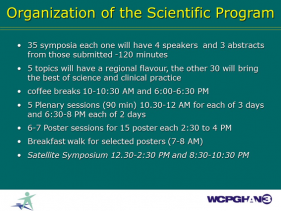
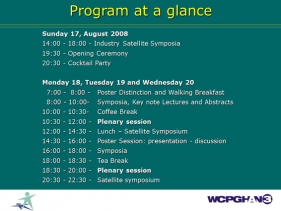
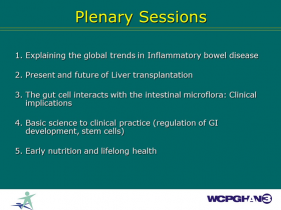
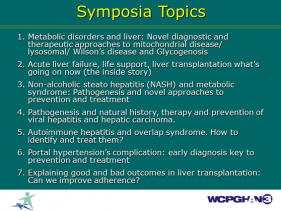
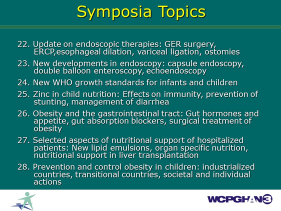
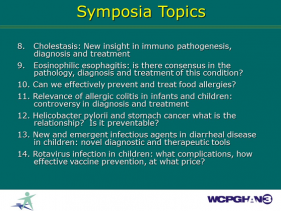
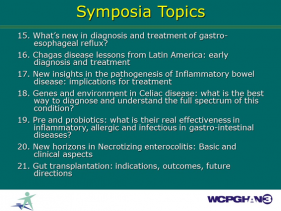
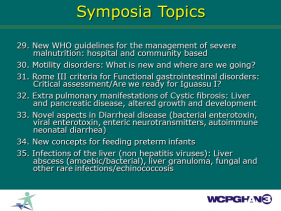
Chamada para inscrição dos Temas Livres
Considerando que o programa final havia sido totalmente elaborado, a próxima tarefa foi anunciar para toda a comunidade cientifica mundial que a organização do evento estava preparada para receber os abstracts para as seções de Temas de Livres.
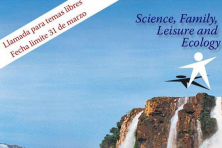
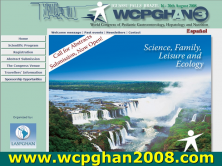
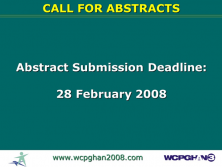
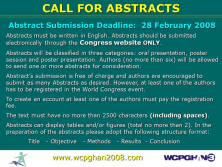
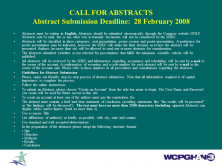
Convite especialmente dirigido aos Pediatras Brasileiros
Vale enfatizar que nossos colegas Pediatras brasileiros foram um alvo particularmente especial da nossa atenção, e, para estimulá-los a participar do evento inicialmente escrevemos ao Presidente da Sociedade Brasileira de Pediatria informando a respeito da realização do evento, e, ao mesmo tempo, solicitando o apoio da mesma e também o convidando para estar presente na cerimonia de abertura do Congresso.
São Paulo 10 de julho de 2007
Ilmo. Sr.
Professor Doutor
Dioclécio
Presidente da Sociedade Brasileira de Pediatria
Estimado Dioclécio:
Em agosto de 2008, de 16 a 19, será realizado o 3° Congresso Mundial de Gastroenterologia Pediátrica, Hepatologia e Nutrição em Foz do Iguaçu. Este evento que ocorre a cada 4 anos é patrocinado pela Federation of the International Societies of Pediatric Gastroenterology, Hepatology and Nutrition (FISPGHAN) e neste ano será organizado pela Lantin-American Society of Pediatric Gastroenterology and Nutrition (LASPGHAN). Como membro da LASPGHAN fui eleito presidente do presente congresso e na sua organização vimos trabalhando com total entusiasmo para que seja algo inesquecível. Neste sentido entendo que o apoio da nossa Sociedade Brasileira de Pediatria torna-se de fundamental importância pela extraordinária relevância nacional e internacional que ela conquistou ao longo dos anos. Assim sendo solicito este apoio formal ao nosso querido Presidente e, ao mesmo tempo, aproveito o ensejo para convidá-lo a participar de todas as atividades do aludido evento. Será para todos nós uma enorme satisfação poder contar com sua presença que seguramente irá abrilhantar o Congresso Mundial e representar condignamente a classe pediátrica brasileira.
Sendo o que se refere para o momento aguardo sua manifestação e aproveito o ensejo para reiterar meus protestos de estima e alta consideração.
Atenciosamente,
Ulysses Fagundes Neto
Presidente, World Congress of Pediatric Gastroenterology, Hepatology and Nutrition 3, Iguassu 2008
Convite especialmente dirigido aos Pediatras Latino-Americanos
Mensaje del Presidente del 3° Congreso Mundial de Gastroenterologia Pediátrica, Hepatología y Nutritición
En nombre de la Sociedad Latinoamericana de Gastroenterologia Pediátrica, Hepatología y Nutrición (LASPGHAN) tengo el enorme placer y honor de invitarlos al Tercer Congreso Mundial de Gastroenterologia Pediátrica, Hepatología y Nutrición que se realizará en Iguazú (en el lado brasileño) en el período de 16 a 20 de agosto de 2008.
Nosotros nos sentimos entusiasmados con la tarea de congregar a las sociedades internacionales líderes de nuestra especialidad en una reunión amplia con el auspicio de la Federación Internacional de las Sociedades de Gastroenterologia Hepatología y Nutrición (FISPGHAN) que nos permitirá reunir los mejores profesionales y científicos involucrados en el campo de la Gastroenteroloiga Pediátrica, Hepatología y Nutrición oriundos de todos los rincones del mundo.
Para encarar este desafío el Comité Ejecutivo Organizador junto con el Comité Ejecutivo Científico han puesto en marcha un programa científico muy atractivo, que funcionará en un medio amigable y de relaciones sociales agradables. El programa resalta las actualizaciones científicas y el conocimiento educacional. Todos los temas de interés actual fueron incluidos dentro de 35 simposios y 5 sesiones plenarias relacionadas al campo de la Gastroenterologia, Hepatología, Endoscopia y Nutrición que serán ofrecidos a los científicos y profesionales. Paralelamente, se ha organizado un evento multiprofesional involucrando Enfermeros, Nutricionistas y Psicólogos para fomentar la interacción entre estos profesionales de la salud y los del área médica con el propósito de estimular la comunicación y la integración de todos aquellos que participan del proceso de cuidar de la salud de los niños y adolecentes.
La ciudad de Foz de Iguazú fue elegida para sede del Congreso Mundial porque es una región donde se encuentran las fronteras de tres países sudamericanos: Brasil, Argentina y Paraguay. Las cataratas del Iguazú sobre el río Iguazú componen un sistema de 275 cataratas a lo largo de 5 kilómetros en la frontera entre Brasil y Argentina y son de una belleza incomparable. Varios parques nacionales donde se encuentra una diversidad rica de fauna y flora rodean esta área. Además de las atracciones turísticas, la ciudad dispone de una red amplia de hotelería que seguramente podrá satisfacer sus necesidades y de sus familias.
Sean bienvenidos al Congreso y vengan disfrutar la hospitalidad de la región.
Atentamente,
Ulysses Fagundes-Neto
Presidente
Informações úteis aos viajantes
Uma vez definida a programação cientifica do Congresso passamos a divulgar as informações para que os congressistas tivessem as maiores facilidades possíveis para chegarem a Foz do Iguaçu. Estes procedimentos tornaram-se necessários, porque a maioria dos colegas contatados manifestava total desconhecimento quanto aos meios de transporte para se chegar a Foz do Iguaçu, e mesmo quanto à própria localização geográfica da cidade de Foz do Iguaçu.
TRAVELLERS’ INFORMATION
FLYING TO BRAZIL
It is advisable to choose a travel agency to help you find the most convenient flight to Brazil according to your hometown. BLUMAR is the official travel agency and will be pleased to assist you in the following website: www.blumar.com.br
You can also contact us via e-mail in the following address: www.wcpghan2008.com
Travelers must carry and show their passports, which should be valid for the next 6 (six) months, counting from the day they enter Brazil. If you need a visa, please contact the nearest Brazilian Consulate in your country several months before the date of the trip. For Latin American countries, except Mexico, there is no visa required. For the vast majority of European countries there is no visa required. For other countries, please consult your travel agent about visa procedures.
Remember that when you check-in at your local airport you have to check-in your luggage to Rio de Janeiro or São Paulo, and you will have to pick it up in one of these airports before checking-in to Iguassu Falls.
ARRIVING IN RIO DE JANEIRO OR SÃO PAULO
- Rio de Janeiro and São Paulo are the most frequent and important gateways for international flights to Brazil. In Rio de Janeiro you will arrive at Tom Jobim International Airport and in São Paulo you will arrive at Guarulhos International Airport. Both airports are relatively small in comparison to the huge airports found in several other countries. Therefore, mobility inside these two airports is much easier than in many other places. There is no need to take trains, mono rails or buses to move within these airports. Everything is reachable at walking distance.
- After leaving the airplane you have to pass through customs to go to the baggage claim area. Even if your ticket indicates Iguassu as the final destination you need to pick up your luggage in Rio de Janeiro or São Paulo. After you have picked up your luggage (karts are free of charge and can be found very easily) go through the sliding door and into the main lobby.
- At the main lobby there will be an official booth of the World Congress and you will be assisted by one of the official hostesses of the Congress. The hostess will take you to the Brazilian airline company counter (TAM or GOL) in order to check-in to Iguassu.
- If, by any reason you miss (it will not happen, just in case) the World Congress booth, there is a Tourist Information Center located in the main lobby in a very visible place. You should go there and ask for assistance. These people are very friendly and they will be pleased to help you.
- BY NO MEANS, DO NOT ACCEPT ANY NON OFFICIAL INFORMATION OR OFFER.
- TAM and GOL offer several (see below) daily non stop flights from Rio de Janeiro and São Paulo to Iguassu and the flight lasts approximately 1:30 hours.
- If you intend to stay in Rio de Janeiro or São Paulo and you need a taxi ride leave the main lobby through the sliding door and you will find a booth of the official taxi company. You should buy a ticket according to the address you may want to go to. Major credit cards are accepted. In Rio de Janeiro the name of the company is Cootramo (blue cars) and in São Paulo it is Guarucop (white cars with a blue stripe). The cars are parked at the sidewalk in front of the booth. There is always an attendant that will assist you with your luggage and to get you into the car. Official taxis are totally safe. When you reach your final destination it is not necessary to tip the taxi driver, but if you want to be generous a small tip like US$ 2-3.00 is very welcome.
ARRIVING IN IGUASSU
- Iguassu airport is very small and easy to move around in it. After leaving the airplane you should go straight to the baggage claim area; as soon as you get your luggage go through the sliding door to the main lobby. There will be an official World Congress booth and an official hostess will assist you to get transportation to your hotel.
- Ground transportation provided by the Congress organization (fee is included in your registration bill) will be waiting for you to take you straight to your hotel.
ADITIONAL INFORMATION – FLIGHTS TO BRAZIL
- ASIA/OCEANIA
Lan
Aerolineas Argentinas
Jal
Korean Airlines
NON-STOP FLIGHTS TO BRAZIL
- EUROPE
British Airways
Lufthansa
Tap
Iberia
Spanair
Air France
Swiss
Alitalia
KLM
Aeroflot
TAM (Brazilian airline)
- NORTH AMERICA
Delta
American Airlines
Air Canada
Aeromexico
United Airlines
TAM (Brazilian Airline)
NON-STOP FLIGHTS TO IGUASSU
- Rio – Galeão – Tom Jobim International
- GOL (05:30/ 08:00 / 11:00 / 15:55 / 18:30 / 19:00 / 21:15)
- TAM (06:45 / 07:00 / 08:40 / 11:00 / 12:30 / 20:05)
- São Paulo – Guarulhos
- GOL (09:30 / 12:30 / 21:50)
- TAM (07:30 / 09:16 / 15:40 / 23:55)
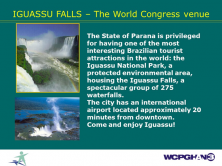
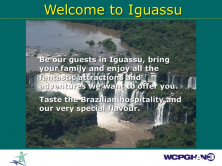
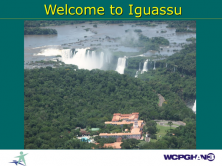
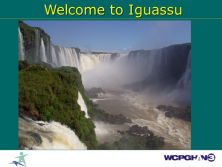
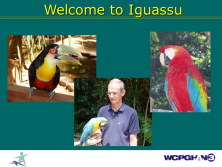
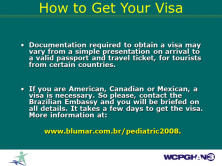
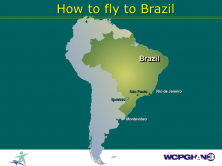
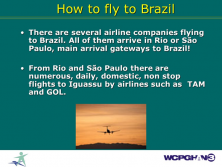
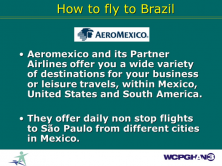
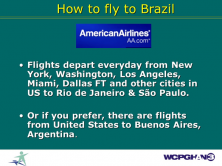
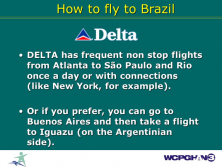
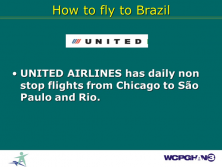
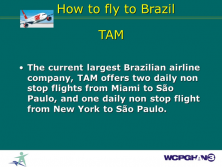
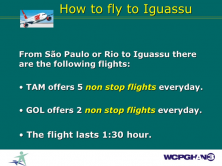
Para viajar al Brasil
Le recomendamos que elija una agencia de viaje para ayudarlo a encontrar el vuelo más conveniente de acuerdo con la ciudad donde vive. BLUMAR es la agencia oficial del Congreso y si acaso usted así lo desea le ayudará a través del sitio: www.blumar.com.br
Los pasajeros deben llevar consigo y mostrar sus tarjetas de identidad o pasaportes, que deberán estar válidos por 6 meses después de la fecha de entrada al Brasil. Si precisa una visa, entre en contacto con el consulado brasilero más cerca en su país varios meses antes de la fecha del viaje. Para países latinoamericanos, excepto Méjico, no es necesaria una visa; ni tampoco para la gran mayoría de los países europeos, pero para otros países, le rogamos consulte su agente de viajes sobre los procedimientos para obtener una visa.
Acuérdese que cuando deje su país debe hacer el “Check in” del equipaje para Rio de Janeiro o San Pablo, y deberá recogerlo en uno de estos aeropuertos antes de embarcar nuevamente para Foz de Iguazú.
Llegando a Rio de Janeiro o San Pablo
- Rio de Janeiro y San Pablo son las puertas de entrada más frecuentes e importantes para vuelos internacionales al Brasil. En Rio de Janeiro, llegará al Aeropuerto Internacional Tom Jobim y en San Pablo llegará al Aeropuerto Internacional de Guarulhos. Ambos son relativamente chicos comparados con los aeropuertos de otros países, por lo tanto, la movilidad dentro de estos aeropuertos es mucho más fácil que en otros lugares. No hay necesidad de tomarse tranvías o mono “rails” ni ómnibus para moverse. Todo está al alcance a pie.
- Después de desembarcar del avión, deberá pasar por la aduana para retirar el equipaje. Aunque su boleto indique Iguazú como el destino final del viaje deberá recoger el equipaje en Rio de Janeiro o San Pablo. Después de recoger su equipaje (los carritos son gratis y se encuentran fácilmente), diríjase por la puerta corrediza al salón principal.
- En el salón principal, encontrará un stand del Congreso Mundial y una de nuestras secretarias del Congreso lo ayudará. La recepcionista lo llevará al mostrador de la compañía aérea brasilera (TAM o GOL) para embarcar a Foz de Iguazú.
- Si por casualidad no encuentra el stand del Congreso Mundial (no pasará, pero lo mencionamos por las dudas) hay un mostrador de información turística muy visible en el salón principal; puede dirigirse a él, lo acogerán y lo ayudarán a encontrar la compañía aérea.
- Le rogamos que no acepte ninguna oferta ni información que no sea oficial.
- TAM y GOL ofrecen (vea a seguir) vuelos diarios directos de Rio de Janeiro y de San Pablo a Foz de Iguazú y el viaje dura aproximadamente 1:30 horas.
- Si piensa quedarse en Rio de Janeiro o San Pablo y precisa tomarse un taxi, salga del salón principal y diríjase pasando por la puerta corrediza a un mostrador de la compañía oficial de taxis. Compre su boleto de acuerdo con la dirección a la que desea llegar. Se aceptan la mayoría de las tarjetas de crédito. En Rio de Janeiro la compañía de taxis se llama Cootramo (coches azules) y en San Pablo es Guarucoop (los coches son blancos con una faja azul). Los coches se encuentran parados en frente al mostrador de la compañía, y siempre hay algún ayudante para ayudarlo a llevar las valijas hasta el coche. Los taxis oficiales son my seguros. Cuando llegar a su destino no hay necesidad de ofrecer una propina, pero si quiere ser generoso US$ 2,00-3,00 es suficiente.
Al Llegar a Iguazú
- El aeropuerto de Foz de Iguazú es chico y muy fácil de moverse. Después de desembarcar diríjase al salón de retirada de equipaje y después de recoger su equipaje diríjase al salón principal por la puerta corrediza. Encontrará un mostrador del Congreso Mundial y una recepcionista lo ayudará a llegar al hotel.
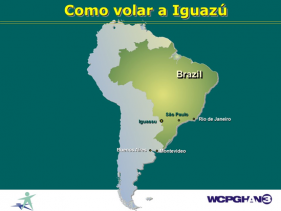
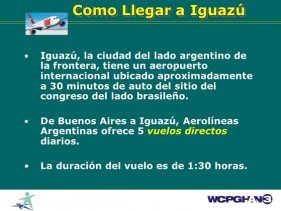
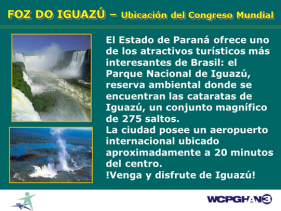
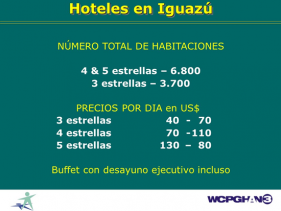
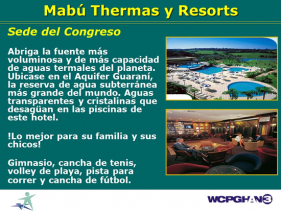
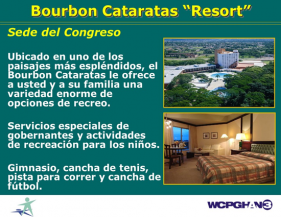
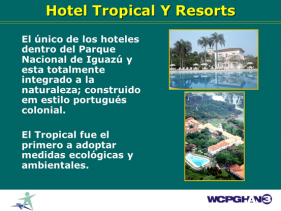
Cronograma de Divulgação do Congresso Mundial entre os colegas Europeus, Norte-Americanos, Latino-Americanos e Asiáticos
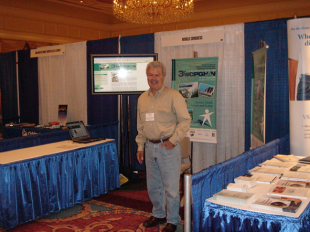
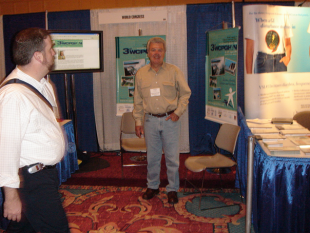
Encuentro 10 MARZO 2008
Sempre tivemos uma constante atenção quanto a importância da divulgação do Congresso Mundial em todas as mídias possíveis, e para este mister utilizamos todos os espaços que nos eram facilitados. Para confirmar esta assertiva, como exemplo, transcrevo abaixo a entrevista que dei à imprensa falada, escrita e televisiva em Buenos Aires, para buscar atrair o maior número possível de participantes.
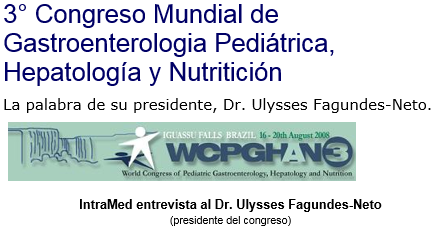
Entrevista por el Dr. Ariel Melamud
¿Cuáles son los antecedentes de este encuentro?
Este será el 3º Congreso Mundial de nuestra especialidad, el primero se realizó en Boston en agosto de 2000 y el segundo en Paris en julio de 2004.
¿Cuáles son sus objetivos principales?
Divulgar los nuevos conocimientos en la área de la Gastroenterología, Hepatología y Nutrición en Pediatría además de estrechar las relaciones entre los profesionales de todo el mundo.
¿De qué manera se organizan las actividades que proponen a los asistentes?
Las actividades son organizadas por el Comite Ejecutivo y el Comité Científico, los cuales están compuestos por miembros elegidos por la Sociedad Latino-Americana de Gastroenterologia Pediátrica, Hepatología y Nutrición y luego sometidas a la aprobación de la Federación Internacional de las Sociedades Regionales, o sea la Norte-Americana, la Europea y la Asiática.
¿Quiénes la componen la Sociedad Latinoamericana de Gastroenterologia Pediátrica, Hepatología y Nutrición y cuál es la distribución geográfica de sus miembros?
La SLAGPHN está compuesta por profesionales involucrados en nuestra especialidad que se dedican a la asistencia, docencia y investigación y actualmente abarca prácticamente todos los países de Latino-América desde México, América Central hasta América del Sur.
¿Qué áreas temáticas quisiera destacar de este 3er Congreso Mundial?
Los aspectos más relevantes y de mayor interés científico están volcados hacia el trasplante hepático, avances en el diagnóstico endoscópico, el binomio diarrea-desnutrición, obesidad, trasplante de intestino, infecciones intestinales, hepatitis, vacunaciones, enfermedad celíca, pro y pre-bióticos, colestasis neonatal, enfermedades metabólicas del hígado, esofagitis eosinofílica, alergia alimentaria, infección por Helicobacter Pylori, reflujo gastro-esofágico, enfermedad inflamatoria intestinal, afecciones funcionales del tracto digestivo, soporte nutricional, afecciones pancreáticas, disturbios de la motilidad del tracto digestivo y nutrición de prematuros.
¿Porqué se eligió America Latina como sede?
Esta fue una decisión de la Federación Internacional, hacer los Congresos de forma rotante entre los continentes que tengan Sociedades definitivamente consolidadas como es el nuestro caso.
¿Cuáles son los invitados especiales en esta oportunidad?
Están invitados cerca de 150 profesionales de todas las partes del mundo que con reconocimiento internacional como productores de nuevos conocimientos y profundamente involucrados con la docencia y asistencia.
Lo invitamos a dejar un mensaje de convocatoria para los colegas.
Invitamos a todos los colegas especialistas y pediatras en general que vengan participar de este“megaevento” absolutamente inédito en nuestra región. Esta es una oportunidad muy especial que se nos presenta y que está geográficamente tan cerca de los latinos y que en sólo 12 años más -en la mejor de las hipótesis- será nuevamente organizado en nuestra región. Además vamos convivir en un ambiente de gran fraternidad en un local que representa la unión de América Latina con la triple frontera como símbolo de esta unión, en un lugar que nos invita a traer toda la familia para disfrutar de las maravillas de la naturaleza que son únicas en todo el mundo.
Como se pode perceber todos os necessários cuidados para tivéssimos um Congresso do mais elevado nível de organização e de excelência de qualidade foram observados nos seus mais mínimos detalhes. Estávamos, portanto, prontos e confiantes de que o evento seria revestido do maior sucesso. Que venha o tão aguardado dia!



